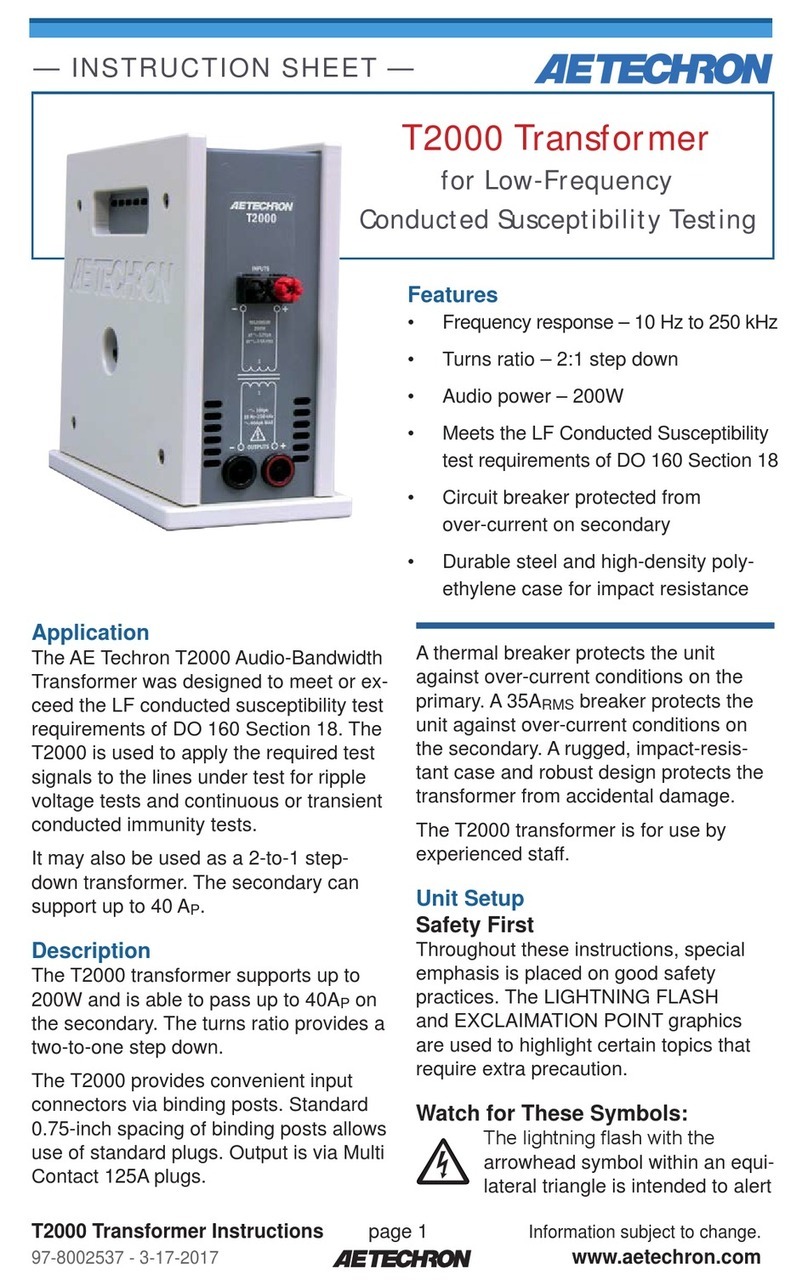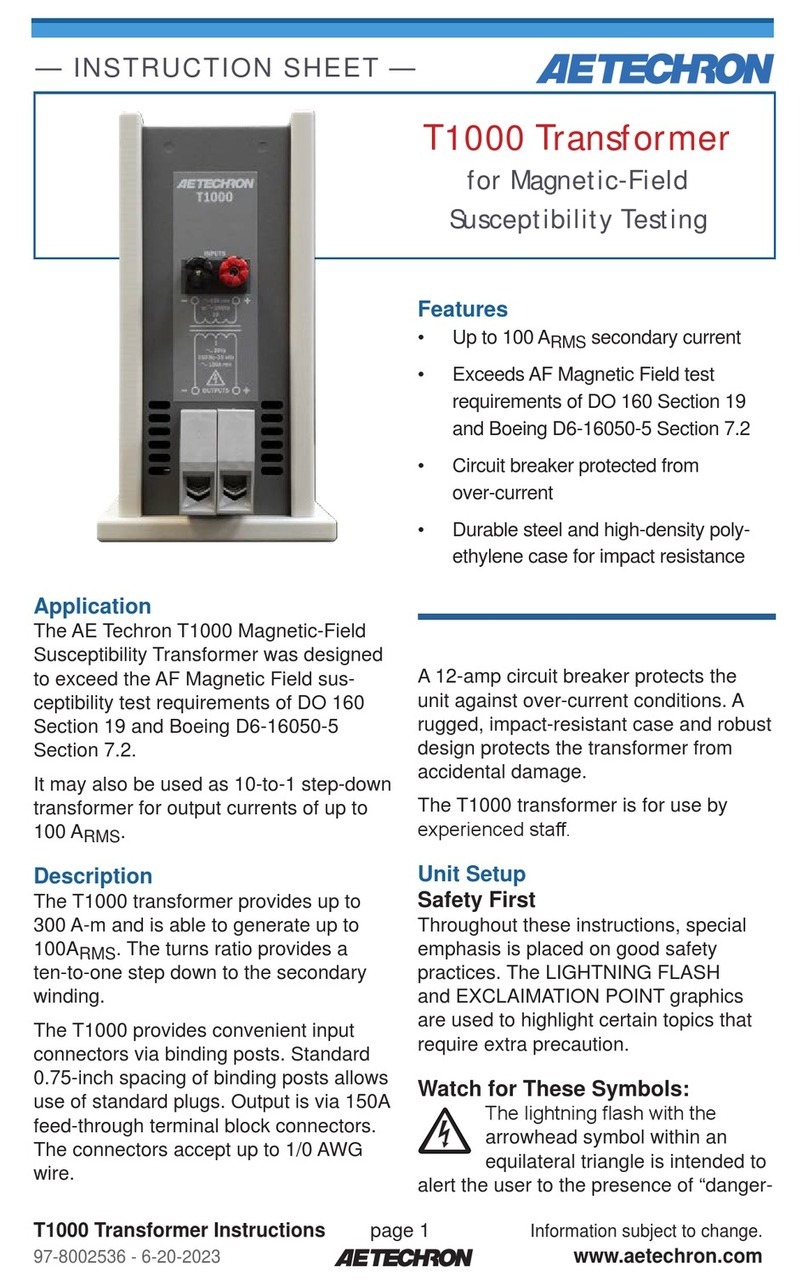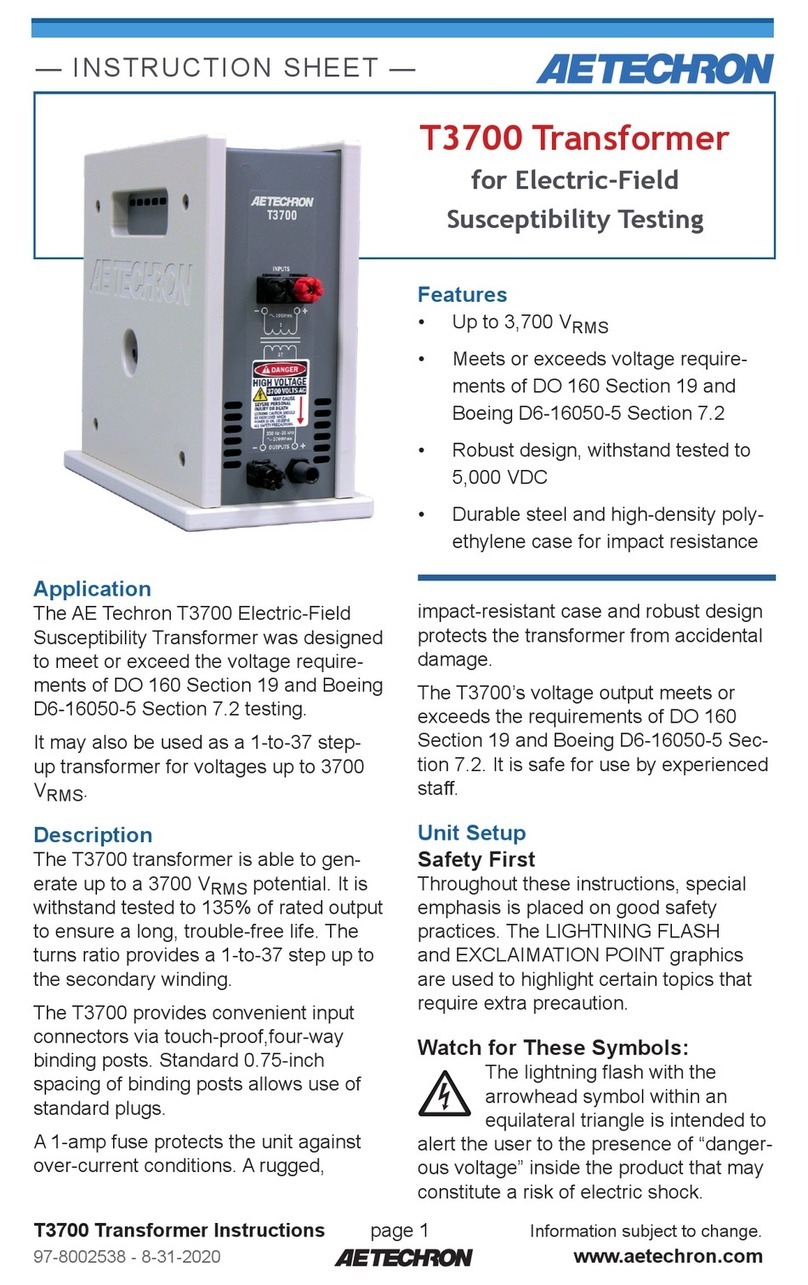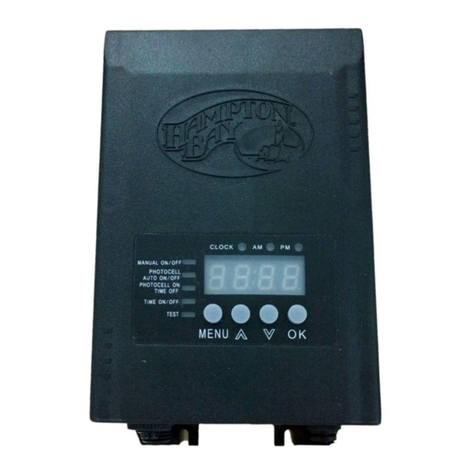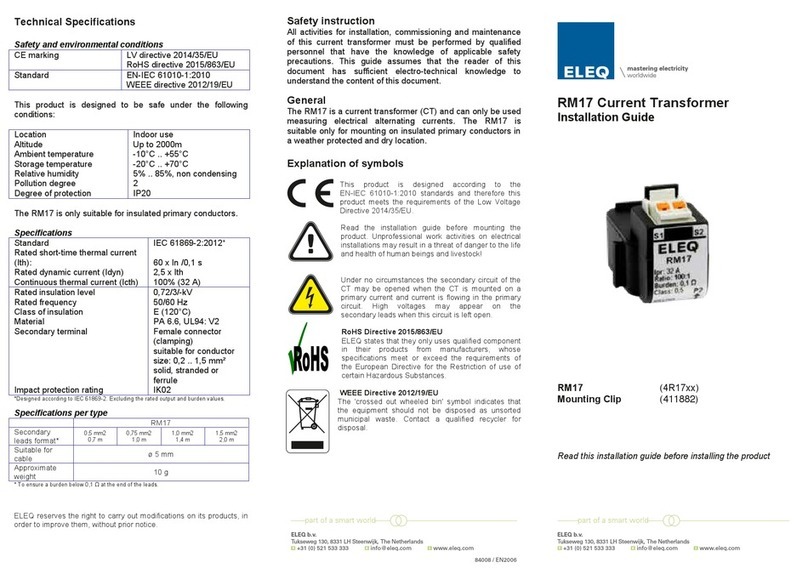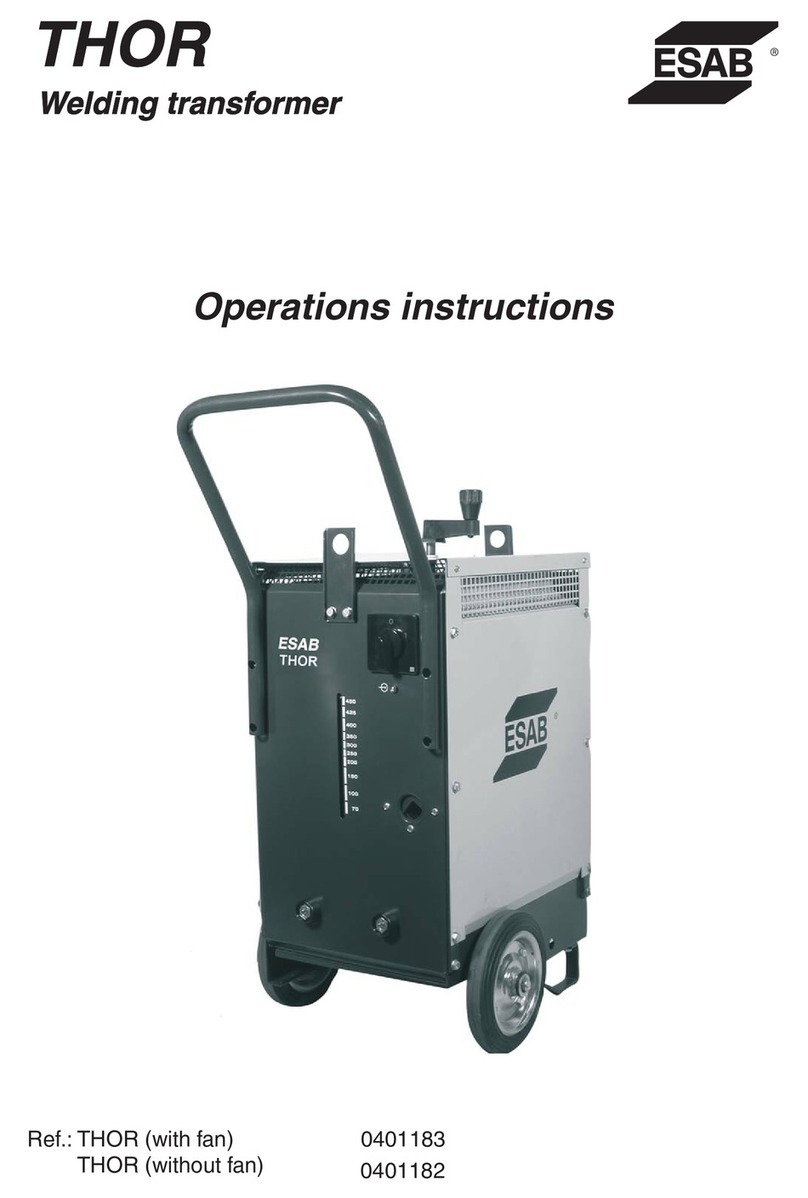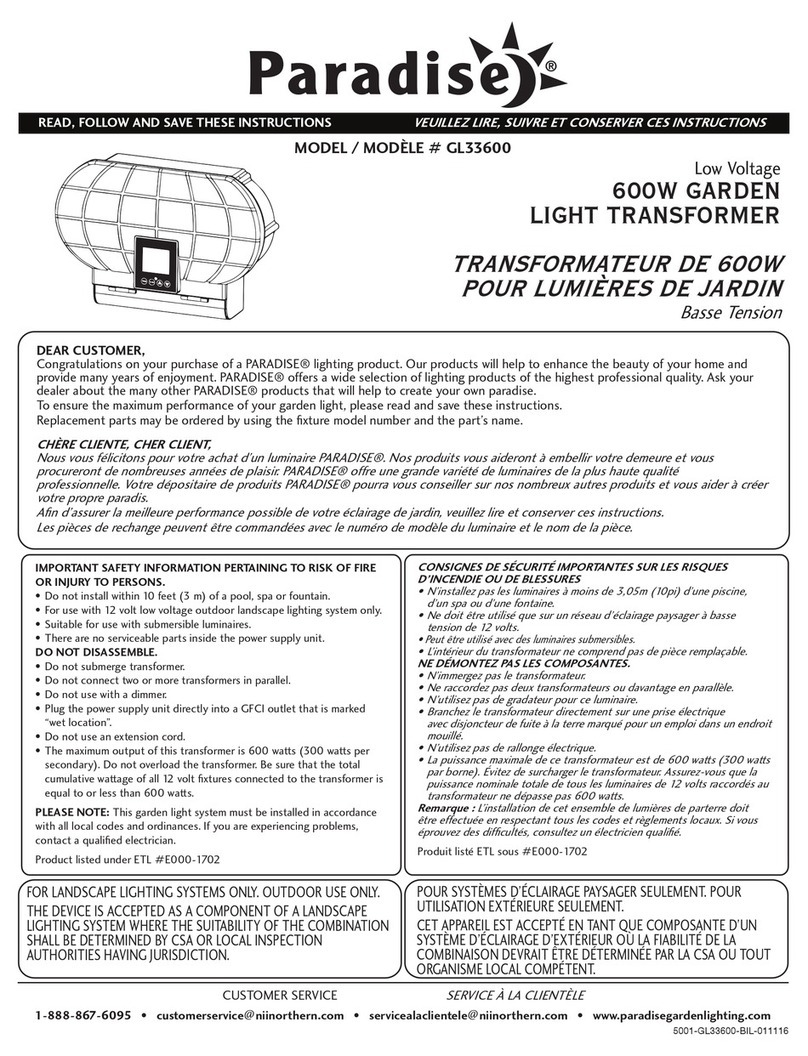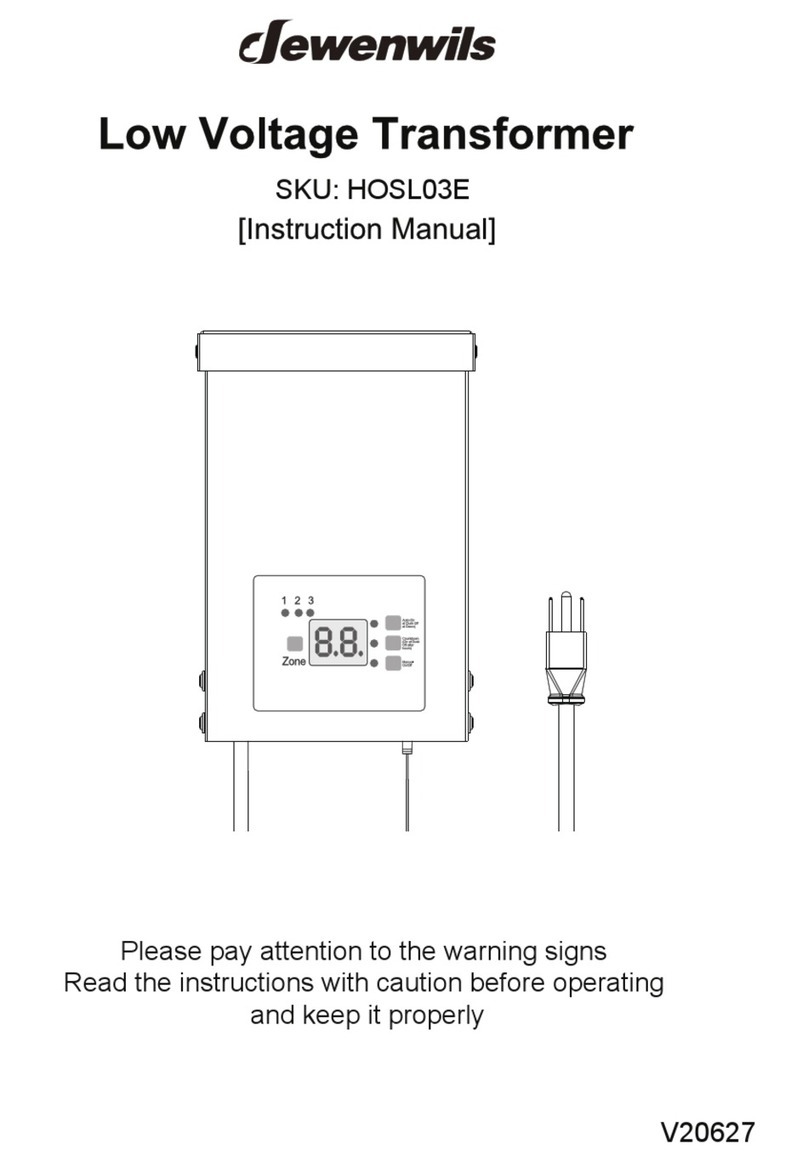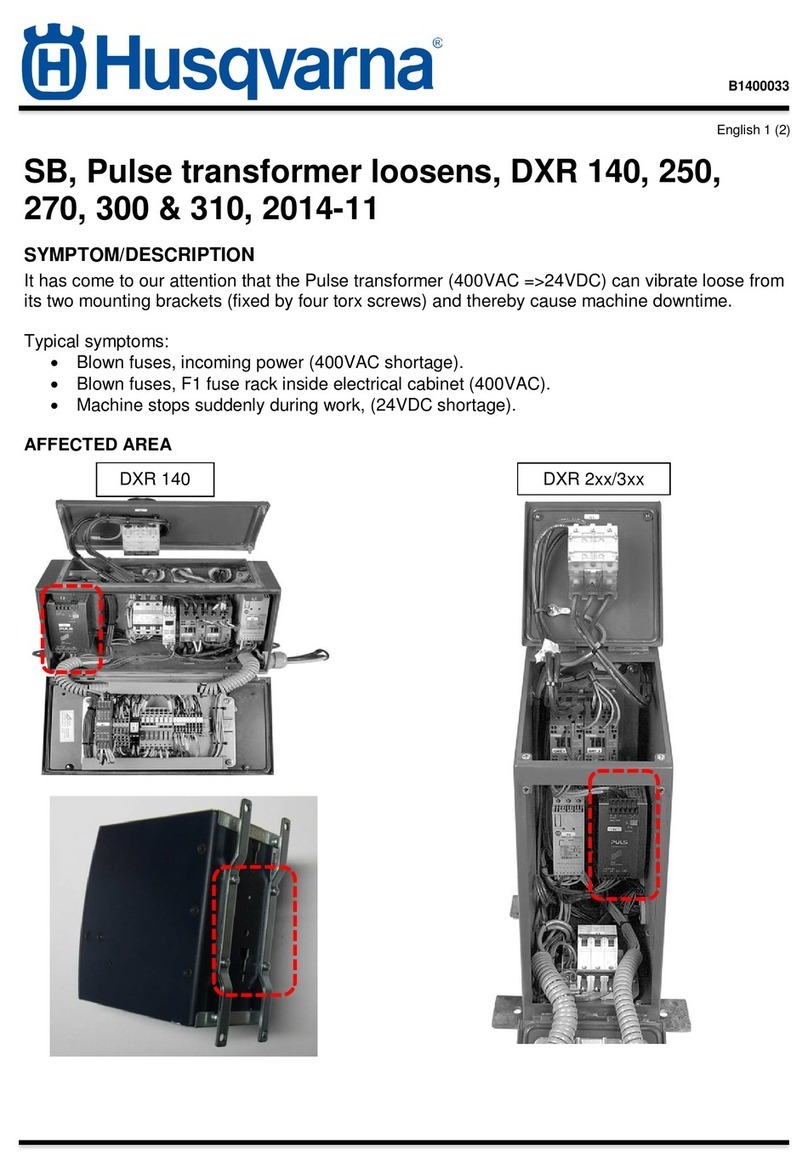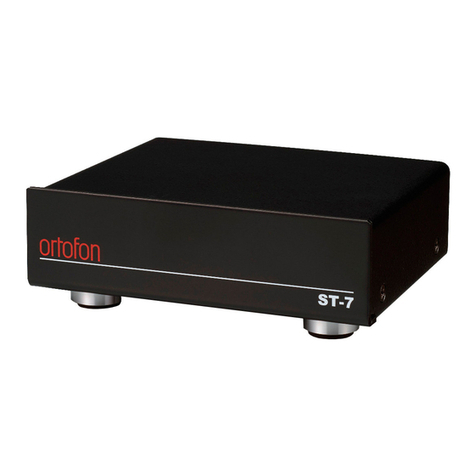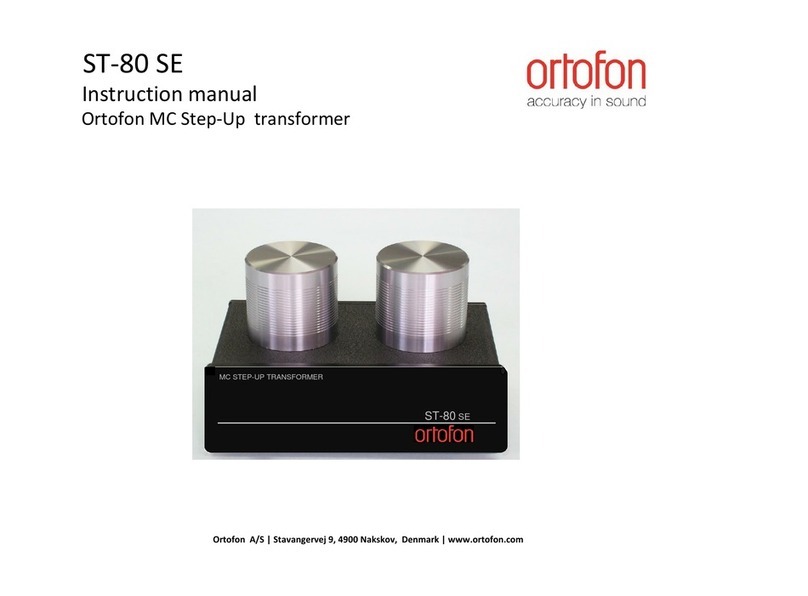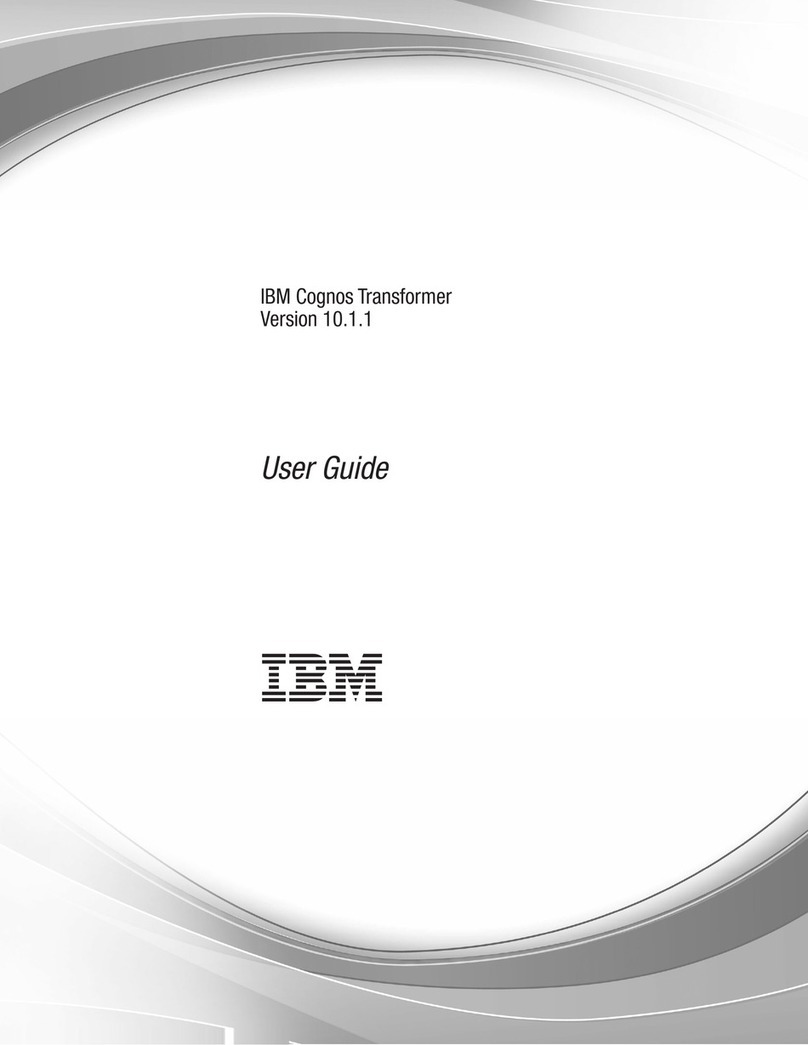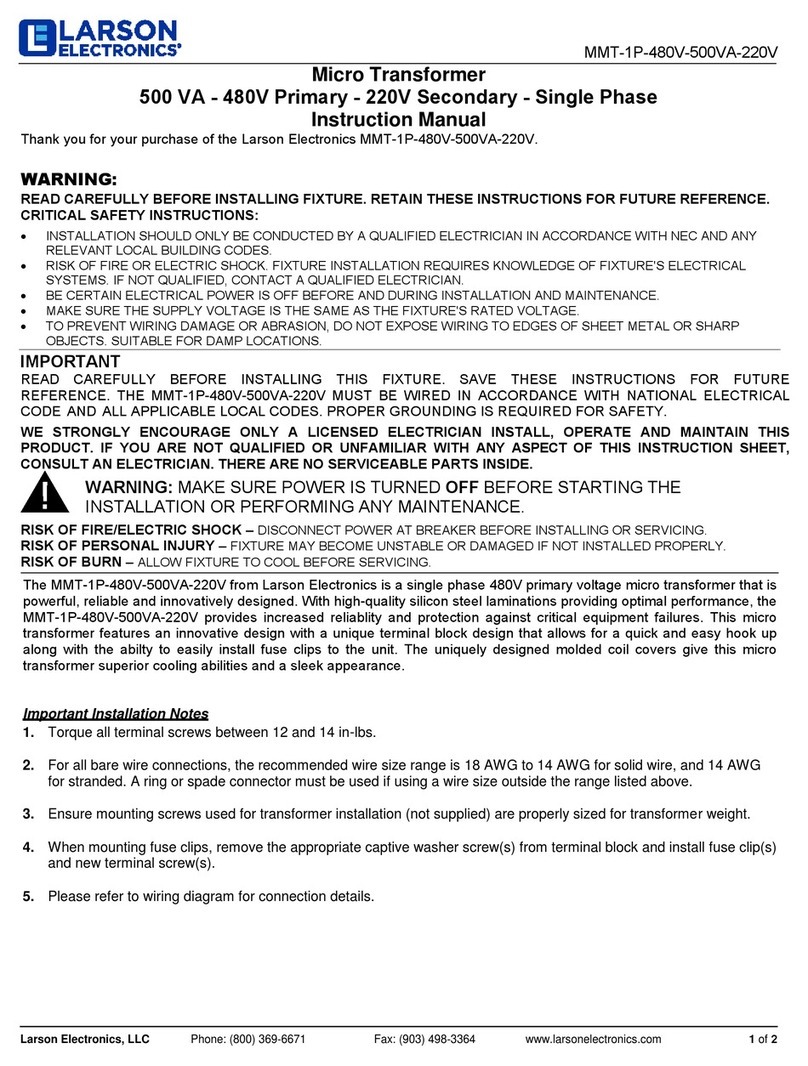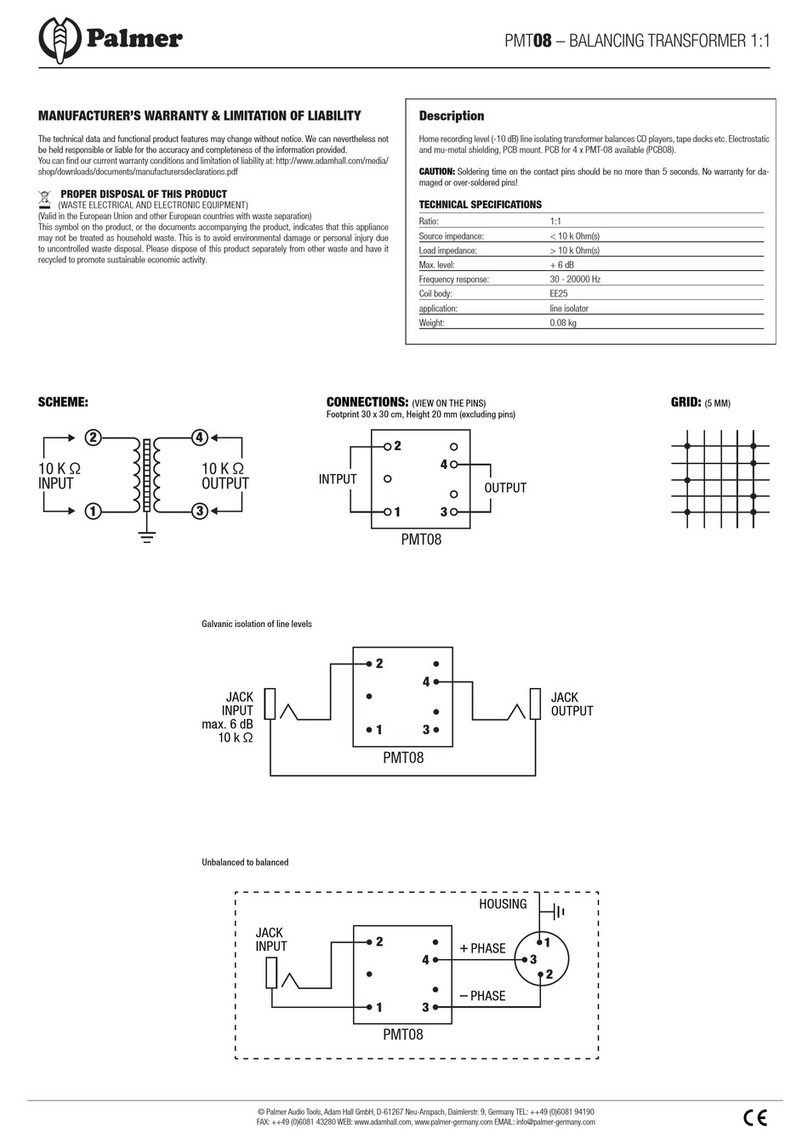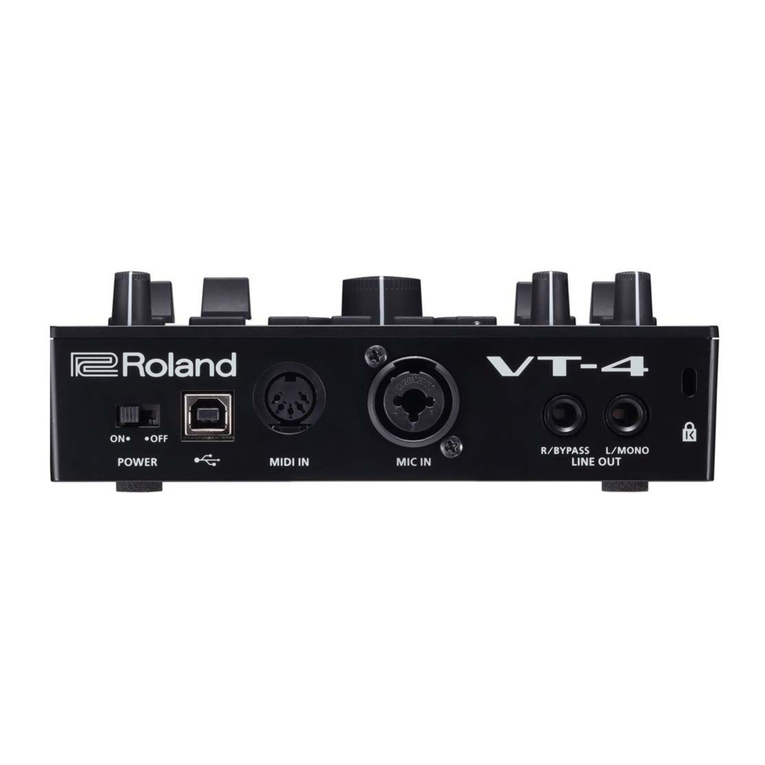Aetechron 8300 Series User manual

8300 Series
Operator’s Manual
Wide-Bandwidth, High-Power Digital Ampliers
Models 8304, 8306, 8308 and 8310
574.295.9495 | www.aetechron.com
2507 Warren Street, Elkhart, IN 46516


Three-Year, No-Fault Warranty
SUMMARY OF WARRANTY
AE TECHRON INC., of Elkhart, Indiana (Warrantor)
warrants to you, the ORIGINAL COMMERCIAL PUR-
CHASER and ANY SUBSEQUENT OWNER of each
NEW AE TECHRON INC. product, for a period
of three (3) years from the date of purchase, by
the original purchaser (warranty period) that the
product is free of defects in materials and work-
manship and will meet or exceed all advertised
specications for such a product. We further war-
rant the new AE Techron product regardless of
the reason for failure, except as excluded in the
Warranty.
ITEMS EXCLUDED FROM WARRANTY
This AE Techron Warranty is in eect only for failure
of a new AE Techron product which occurred within
the Warranty Period. It does not cover any product
which has been damaged because of any intentional
misuse, or loss which is covered under any of your
insurance contracts. This warranty does not extend
to any product on which the serial number has been
defaced, altered, or removed. It does not cover dam-
age to loads or any other products or accessories
resulting from AE TECHRON INC. product failure. It
does not cover defects or damage caused by the use
of unauthorized modications, accessories, parts, or
service.
WHAT WE WILL DO
We will remedy any defect, regardless of the reason
for failure (except as excluded), by repair or replace-
ment, at our sole discretion. Warranty work can only
be performed at our authorized service centers or at
our factory.
Expenses in remedying the defect will be borne by
AE TECHRON INC., including one-way surface
freight shipping costs within the United States.
(Purchaser must bear the expense of shipping the
product between any foreign country and the port of
entry in the United States and all taxes, duties, and
other customs fees for such foreign shipments.)
HOW TO OBTAIN WARRANTY SERVICE
When you notify us or one of our authorized service
centers of your need for warranty service, you will
receive an authorization to return the product for
service. All components must be shipped in a factory
pack or equivalent which, if needed, may be obtained
from us for a nominal charge. We will take corrective
actions and return the product to you within three
weeks of the date of receipt of the defective prod-
uct, or will make available to you a product of equal
or better performance on temporary loan until your
product can be repaired or replaced and returned to
you. If the repairs made by us are not satisfactory,
notify us immediately.
DISCLAIMER OF CONSEQUENTIAL AND
INCIDENTAL DAMAGES
You are not entitled to recover from us any conse-
quential or incidental damages resulting from any
defect in our product. This includes any damage to
another product or products resulting from such a
defect.
WARRANTY ALTERATIONS
No person has the authority to enlarge, amend, or
modify this warranty. The warranty is not extended by
the length of time for which you are deprived of the
use of this product. Repairs and replacement parts
provided under the terms of this warranty shall carry
only the unexpired portion of this warranty.
DESIGN CHANGES
We reserve the right to change the design of any
product from time to time without notice and with no
obligation to make corresponding changes in prod-
ucts previously manufactured.
LEGAL REMEDIES OF PURCHASER
There is no warranty that extends beyond the terms
hereof. This written warranty is given in lieu of any
oral or implied warranties not contained herein. We
disclaim all implied warranties, including, without
limitation, any warranties of merchantability or tness
for a particular purpose. No action to enforce this
Warranty shall be commenced later than ninety (90)
days after expiration of the warranty period.
This statement of warranty supersedes any others
contained in this manual for AE Techron products.
AE TECHRON INC.
Customer Service Department
2507 Warren St. Elkhart, IN, 46516, U.S.A.
(574) 295-9495
www.aetechron.c

Contents
1 Introduction ....................................................................................................................................5
1.1 Features ................................................................................................................................5
1.2 Conguration Options............................................................................................................5
2 Amplier Unpacking and Installation..............................................................................................6
2.1 Safety First ............................................................................................................................6
2.2 Unpacking .............................................................................................................................6
2.3 Check Contents.....................................................................................................................6
2.4 8300 Series Placement .........................................................................................................6
2.5 Installing the Pagoda Top ......................................................................................................7
3 Connections and Startup ...............................................................................................................9
3.1 Testing Before Controlled-Current Operation .......................................................................9
3.2 Connecting the Load .............................................................................................................9
3.3 Connecting the Input Signal ................................................................................................10
3.4 Other DIP Switch Settings................................................................................................10
3.5 Monitor and Sense Ports..................................................................................................10
3.6 Connecting the AC Supply ..................................................................................................10
3.7 Start-up Procedure..............................................................................................................12
4 Amplier Operation ......................................................................................................................13
4.1 Front-Panel Controls and Indicators....................................................................................13
4.2 Back-Panel Controls & Connectors....................................................................................15
4.3 Back-Panel Safety Features...............................................................................................15
5 Advanced Conguration...............................................................................................................16
5.1 DIP Switch Congurations...................................................................................................16
6 Applications..................................................................................................................................20
6.1 Controlled-Current Operation..............................................................................................20
6.2 Driving Reactive Loads .......................................................................................................23
7 Maintenance ................................................................................................................................24
7.1 Clean Amplier Filter and Grills ...........................................................................................24
8 Troubleshooting ...........................................................................................................................25
8.1 Introduction & Precautions ..................................................................................................25
8.2 Visual Inspection .................................................................................................................25
8.3 No Signal.............................................................................................................................25
8.4 No LEDs Illuminated............................................................................................................25
8.5 Over/Under Line LED Lit .....................................................................................................25
8.6 Run/Standby LED Remains Amber .....................................................................................26
8.7 Amplier Overheats (Over Temp Fault Condition)...............................................................26
8.8 Fault LED is Illuminated ......................................................................................................26
8.9 Factory Service ...................................................................................................................27
Appendix A: Gain DIP Switch Settings ..............................................................................................28
Appendix B: Amplier Module Wiring Diagrams ................................................................................34

96-8006125_11-03-21 Information subject to change 5
8300 SERIES OPERATOR’S MANUAL – SECTION 1
1 Introduction
Congratulations on your purchase of an 8300 se-
ries digital power amplier. 8300 series ampliers
are 200Vp, low-noise, DC-to-50 kHz switch-mode
ampliers. They are fast enough for DC automo-
tive dropout testing and capable of AC voltages
required for ISO 61000 and Aviation testing. Plus,
they have low enough noise and distortion speci-
cations to be the reference power source in power
quality measurements.
1.1 Features
Wide Bandwidth and Flexible
The 8300 series amplier is capable of reproduc-
ing AC, DC and AC+DC waveforms into loads from
a dead short to high impedance. It can be used to
simulate a battery at 13.5 VDC or be an AC source
with a L-N potential of up to 140 VAC. Rated cur-
rent, for a given voltage, is available for all wave-
form types (AC, DC or AC+DC) at frequencies
from DC to 50 kHz. Voltages from 0 to 140 VRMS
are available with no changes in conguration.
Reuses Energy from Reactive Loads
The 8300 series excels when it comes to driv-
ing reactive loads. As frequencies increase, the
eective-impedance of the load becomes a much
larger part of the total load to be driven (especially
with inductive loads like coils).
However, when driving reactive loads, the 8300
series amplier is capable of receiving, reprocess-
ing and returning to the load up to 5X its rated
power. The result is a system capable of up to 50
kVA output while drawing less than 10 kW of AC
mains power!
1.2 Conguration Options
A key to everyday product usability is quick and
easy product (re)configuration. The 8300 series
amplifier provides all key configuration controls on
the back panel of the unit. Configuration options
available include:
• Gain: Fixed or variable gain (0 to 40)
• Current Limit: From 5% to rated limit (to
protect fragile DUTs or where specified in the
Standard)
• DC Control: DC enabled or DC blocked and
DC Servo (for driving transformer-coupled
loads, coils)
• Input: Balanced and/or unbalanced
• Mode: Voltage source or current source
• Output Impedance: Variable from 0 to 1 ohm
(Voltage mode)
• Sense: Correction to voltage drops to the load
Figure 1.1 – 8300 Series Front Panel
Performance Overview
Bandwidth DC - 50 kHz
Voltage 0 to 140 VRMS; 0 to 200 VDC
Current Up to 300 ARMS
Distortion 0.2%
Power Up to 10 kW
Apparent Power Up to 50 kVA

Information subject to change 96-8006125_11-03-21
8300 SERIES OPERATOR’S MANUAL – SECTION 2
6
DANGER represents the most severe
hazard alert. Extreme bodily harm or
death will occur if these guidelines are
not followed. Note the explanation of the
hazard and instruction for avoiding it.
DANGER
WARNING alerts you to hazards that
could result in severe injury or death.
Note the explanation of the hazard and
the instructions for avoiding it.
WARNING
CAUTION indicates hazards that could
result in potential injury or equipment
or property damage. Once again, note
the explanation of the hazard and the
instructions for avoiding it.
CAUTION
Never attempt to lift the cabinet without
assistance. Crushing bodily injury can
result if care is not taken during instal-
lation. Cabinets may overturn if not
secured.
WARNING
Figure 2.1 – Cable Lift Rings
2 Amplier Unpacking and
Installation
8300 series ampliers are precision instruments
that can be dangerous if not handled properly. Le-
thal voltages are present in both the AC input sup-
ply and the output of the amplier. For this reason,
safety should be your primary concern when you
setup and operate this amplier.
2.1 Safety First
Throughout this manual special emphasis is
placed on good safety practices. The following
graphics are used to highlight certain topics that
require extra precaution.
2.2 Unpacking
Your amplier will be delivered to the ship-to ad-
dress enclosed in a wooden crate and transported
on a special, shock-absorbing pallet. With the
addition of packaging, the amplier can weigh up
to 700 pounds (318 kg). To avoid serious injury
and/or product damage, use a heavy-duty lift or
other suitable equipment to unpack and move the
product to its place of installation.
To uncrate the product, remove the top and one
side of the crate, then use a lift or other suitable
equipment to glide the amplier from the crate and
o the pallet. Cable lift rings are installed at the
amplier top corners to facilitate product removal
(see Figure 2.1).
The amplier has been tested and inspected for
damage before leaving the factory. Carefully un-
pack and inspect the product for damage. Please
note any damage for future reference and
notify the shipping company immediately if
damage is found. Also, please save the shipping
crate and pallet as evidence of damage and/or for
returning the amplier for repair.
2.3 Check Contents
In addition to the 8300 series amplier, your ship-
ment should include the following:
1. Pagoda top
2. Quick Start Guide
3. 8300 series Operation Manual on USB drive
2.4 8300 Series Placement
8300 series ampliers are mounted on wheels to
allow rolling on a at, smooth surface. To avoid
possible tipping, always push the amplier from
the front and avoid rough or pitted surfaces.
Locate your amplier near a three-phase power
source. Allow enough clearance at the front and

96-8006125_11-03-21 Information subject to change 7
8300 SERIES OPERATOR’S MANUAL – SECTION 2
Figure 2.3 – Removing the Lift Rings
Figure 2.5 – Pagoda Top Installation Hardware
Figure 2.4 – Removing the Top Screen
Figure 2.2 – Clearance Recommendations
for Amplier Placement
back of the amplier to allow adequate airow and
hot air discharge through the amplier rear. See
Figure 2.2 for clearance recommendations.
ware for later use. Note that the lifting bracket
will remain installed in the chassis. See Figure
2.3.
2.5 Installing the Pagoda Top
A pagoda top has been shipped separately from
the product. To install the pagoda top on the prod-
uct, the cable lift rings must be removed. Ensure
that the product is un-crated and located near its
nal installation site before installing the pagoda
top.
Complete the following steps to remove the lift
rings and install the pagoda top.
1. Remove the two side panels of the product by
loosening the lock screws in the side panel
and then lifting the panel up and away from the
product frame.
2. Locate the four bolts securing the cable lift
rings to the lift-kit cross bars. Working on the
interior of the product chassis, remove each
bolt and then remove the ring from the top of
the product. Reserve the lift rings and hard-
3. Locate the four screws securing the screen
top. Remove the screws and then lift the
screen top o from the frame. The screen top
can be reserved or discarded. See Figure 2.4.
4. Remove the screws, washers and nuts from
the pagoda top, marking or otherwise noting
the locations in the top where they were insert-
ed (these locations will be used when installing
the top on the frame. See Figure 2.5.

Information subject to change 96-8006125_11-03-21
8300 SERIES OPERATOR’S MANUAL – SECTION 2
8
5. Locate the four mounting holes located just
inside the lift-kit cross bars at the top of the
product. See Figure 2.6.
6. Set the pagoda top onto the product top, mak-
ing sure the anges of the top rest in the inset
on the product top.
7. Place one washer on each screw and, work-
ing from the interior of the chassis, slide the
screw through the product mounting hole and
into the pagoda top. Secure using the supplied
nut. Repeat for the other three corners of the
pagoda top.
Figure 2.6 – Pagoda Top Mounting Hole Locations

96-8006125_11-03-21 Information subject to change 9
8300 SERIES OPERATOR’S MANUAL – SECTION 3
3 Connections and Startup
This section details the wiring and startup pro-
cedures for an 8300 series amplier operating in
Controlled-Voltage mode (factory default). Before
connecting the amplier inputs and outputs, make
sure the AC power is disconnected.
3.1 Testing Before Controlled-Current
Operation
IMPORTANT: If your application requires Con-
trolled Current operation, the 8300 series amplier
rst should be wired and tested in Controlled-
Voltage mode to verify that the amplier and input
signal are operating correctly. Once proper opera-
tion is conrmed, refer to the Applications sec-
tion of this manual for instructions on conguring
and operating your amplier in Controlled-Current
mode.
3.2 Connecting the Load
3.2.1 Preparation and Cautions
Before connecting the amplier, make sure the
AC power is disconnected.
Always use the appropriate wire size and insula-
tion for the maximum current and voltage expected
at the output. Never connect the output of the
amplier to any other model amplier, power sup-
ply, signal source, or other inappropriate load; re
can result.
Figure 3.1 – 8300 series I/O Panel (back panel)
ELECTRIC SHOCK HAZARD.
Output potentials can be lethal. Make
connections only with AC Power OFF
and input signals removed.
WARNING
POTENTIAL SHOCK AND FIRE HAZARD.
Torque 3/8” nuts on output terminals to 10 lbs./
ft. with or without cables connected.
WARNING
ELECTRIC SHOCK HAZARD.
Follow these safety precautions before
opening the amplier’s back access
door:
• Disconnect the AC power supply.
• Wait at least 3-5 minutes after
disconnecting AC power before
opening the access door.
• Wear safety goggles.
• Contact AE Techron Technical
Support for any questions or
concerns.
WARNING
3.2.2 Output Connections
Connection to the output of the amplier is to a
pair of high-current output terminals located on
the amplier back I/O panel. Wires terminated with
3/8-inch ring terminals are recommended when
connecting to the output terminals. Connect the
load across the terminals marked “OUTPUT” (posi-
tive) and “GND” (ground). The GND terminal also
can be connected to an external ground point such
as the amplier chassis, if desired. See Figure
3.2.

Information subject to change 96-8006125_11-03-21
8300 SERIES OPERATOR’S MANUAL – SECTION 3
10
Figure 3.2 – Connecting the Load
Figure 3.3 – Wiring for Unbalanced or Balanced
Input Connector
3.3 Connecting the Input Signal
Both an unbalanced Input BNC jack and a bal-
anced Input “WECO” terminal block connector
(mating WECO connector provided) are available
on the amplier back I/O panel for signal input.
Connect your input signal source to the unbal-
anced or balanced input connector as shown in
Figure 3.3. Use cables that are high quality and
shielded to minimize noise and to guard against
possible feedback.
Figure 3.4 – DIP Switch Locations for
Input Connector Enable/Disable
enabled. When the DIP switches are placed in the
DOWN position, the input connectors are disabled.
See Figure 3.4 for DIP switch locations.
3.4 Other DIP Switch Settings
Other DIP switches located on the amplier mod-
ule labeled “Master” can be used to enable fea-
tures or congure the amplier for special applica-
tions. See the Advanced Conguration section of
this manual for more informaiton. Before operating
the amplier, check to make sure all DIP switches
are set as intended. See Figure 5.1 for the factory
default setting for all DIP switches.
3.5 Monitor and Sense Ports
The amplier provides three additional ports on the
back I/O panel:
• Current Monitor (BNC connector)
• Voltage Monitor (BNC connector)
• Remote Sense Port (2-pin terminal block con-
nector.
See the Applications section of this manual for
information on using these ports
3.6 Connecting the AC Supply
Always operate the amplier from the proper AC
mains. The 8300 series amplier requires three-
phase, 50-60 Hz, 208 VAC (or optional 400 VAC)
with no more than +10%/-20% variance above or
below the line voltage. The amplier will not oper-
ate properly outside these limits.
DIP switch #1, located on the back panel of the
Master amplier module (uppermost module in the
amplier) can be used to enable/disable the unbal-
anced input connector, and DIP switch #2 can be
used to enable/disable the balanced input connec-
tor.
When these two DIP switches are placed in the UP
position (factory default), the input connectors are

96-8006125_11-03-21 Information subject to change 11
8300 SERIES OPERATOR’S MANUAL – SECTION 3
Figure 3.5 – Location of AC Mains Barrier Strip
Full AC requirements by product model are de-
tailed below:
MODEL 208V (±10%) 400V (±10%)
8304 30A, 50/60 Hz 15A, 50/60 Hz
8306 30A, 50/60 Hz 15A, 50/60 Hz
8308 60A, 50/60 Hz 30A, 50/60 Hz
8310 60A, 50/60 Hz 30A, 50/60 Hz near the bottom of the amplier. Locate the
power block, which is mounted behind the fuse
and AC inlet panel (see Figure 3.5).
4. Route the 5-conductor power input cable into
the amplier through the cable strain relief
(located on the fuse and AC inlet panel).
5. Connect to the AC mains barrier strip as shown
in Figure 3.6. See Appendix B for wiring dia-
grams of the complete AC power systems.
6. If connecting to an AC power cord, verify con-
nector wiring for phases, neutral and safety
ground. Verify that proper phase, neutral and
safety ground connections have been made at
the AC mains breaker.
The risk of lethal ELECTRICAL SHOCK
exists when connecting AC mains!
Disconnect the source before connect-
ing AC power wires to the amplier’s AC
inputs.
DANGER
ELECTRIC SHOCK HAZARD. Power
supply wiring should only be performed
by a qualied, licensed electrician.
WARNING
Complete the following steps to connect the ampli-
er to your three-phase power source:
1. Wear safety goggles.
2. Disconnect your AC power source.
3. Open the access door on the back of the am-
plier and locate the fuse and AC inlet panel

Information subject to change 96-8006125_11-03-21
8300 SERIES OPERATOR’S MANUAL – SECTION 3
12
3.7 Start-up Procedure
1. Turn down the level of your signal source.
2. Make sure the Emergency Stop button on
the front panel is in the ON position (not
depressed).
3. Make sure the back panel access door is
closed and the breaker switch (near the
bottom of the amplier rear) is in the ON
position.
4. Press the front-panel POWER switch to
turn the amplier ON.
5. Wait until the Run/Standby indicator turns
solid green.
6. Adjust your input signal level to achieve
the desired output level.
Figure 3.6 – Three-Phase AC Mains Wiring

96-8006125_11-03-21 Information subject to change 13
8300 SERIES OPERATOR’S MANUAL – SECTION 4
4 Amplier Operation
4.1 Front-Panel Controls and Indicators
This section provides an overview of Front-Panel
controls and indicators found on the 8300 series
amplier. Refer fo Figure 4.1 for component loca-
tions.
4.1.1 Power Switch
The Power switch controls the power to the am-
plier’s high-voltage transformers. Switch to the
ON position (|) to energize the amplier. Switch to
the OFF position to remove power from the high-
voltage transformers and place the amplier in
Standby mode.
4.1.2 Run/Standby Indicator
Run mode: The indicator will be lit solid green.
The amplier’s high-voltage transformers are ener-
gized and the unit will amplify the input signal.
Standby mode: The indicator will be lit solid am-
ber. The amplier will be placed in Standby when
one of the following conditions occurs:
POWER
ON/OFF
EMERGENCY
STOP
RUN/STANDBY
INDICATOR
SIGNAL/OVERLOAD
INDICATOR
FAULT INDICATOR
OVERTEMP INDICATOR
HIGH/LOW LINE INDICATOR
Figure 4.1 – Front Panel Controls and Indicators
1. High/Low Line error
2. Overtemp condition
3. Fault condition
4. The user presses the front-panel power switch
to the OFF (O) position.
In Standby mode, the amplier’s low-voltage trans-
former is energized but the high-voltage transform-
ers are not.
To release the amplier from Standby mode:
1. High/Low Line error: Clear the over- or
under-voltage condition. The amplier will
resume operation when the input voltage is
brought within the operating range of the ampli-
er. More information is available in the High/
Low Line Indicator topic in this section.
2. Overtemp condition: Leave the amplier
in Standby mode with the fans operating to
cool the amplier. When the amplier’s inter-
nal temperature drops to less than 100°C, the
amplier will resume operation. Note that in

Information subject to change 96-8006125_11-03-21
8300 SERIES OPERATOR’S MANUAL – SECTION 4
14
cases where the amplier’s transformers have
overheated, up to15 minutes of cooling time
may be required before the amplier can re-
sume operation. See the Overtemp Indicator
topic in this section for more information.
3. Fault condition: Press the front-panel power
switch to reset the amplier. If the fault condi-
tion recurrs or does not clear, the amplier may
require servicing. See the Troubleshooting
section for more information.
4. Power switch pressed: When the amplier is
operating (Run mode), pressing the front-panel
power switch will place the amplier in Standby
mode. Press the power switch again to release
the amplier from Standby and return the am-
plier to Run mode.
4.1.3 Signal/Overload Indicator
Signal Presence: When an input signal is pre-
sented at an active signal input on the amplier
at a level greater than 0.5V, the Signal/Overload
indicator will light solid green.
Overload (clipping): The indicator will ash amber
intermittantly. When the indicator ashes amber, this
indicates that the output of the system could not fol-
low the input signal due to voltage or current limits.
The amber Overload indicator will begin ashing
when distortion is greater than 0.1%.
4.1.4 High/Low Line Indicator
This amber indicator will illuminate and the ampli-
er will be placed in Standby if the detected AC
mains voltage is outside of the operable range
of the amplier (±10%). This can occur when the
amplier’s rear panel breaker is o or tripped. It
can also occur when the AC supply voltage to the
amplier is too high or too low.
To remove the amplier from Standby, the AC
mains voltage must be brought to within the opti-
mal range. Check the amplier back panel breaker
and reset or turn the breaker on, if needed. If the
error does not clear, check the voltage from the AC
mains. Once the fault condition has been cleared,
the amplier will return automatically to Run mode.
If the High/Low Line indicator does not turn o or
if the amplier does not return from Standby, the
amplier may require servicing. See the Trouble-
shooting section for more information.
4.1.5 Overtemp Indicator
The amplier monitors the temperature inside the
high-voltage transformers and in the output stage
heat sinks. The amber Overtemp indicator will light
and the amplier will be placed in Standby mode
when the temperature sensors detect a condition
that would damage the amplier. If the Overtemp
pulse is extremely short, as in the case of defec-
tive wiring or switches, this indicator may be lit too
briey to observe.
To remove the amplier from Standby and return
it to normal operation after an Overtemp fault has
occurred, make sure the amplier fans are running
and then remove the input signal from the amplier.
Allow the fans to run until the amplier automatically
returns to Run mode. See the Troubleshooting
section for information on identifying and correcting
the cause of an Overtemp fault condition.
4.1.6 Fault Indicator
The red Fault indicator will light and the amplier
will be placed in Standby under two conditions:
1. High frequency oscillation is causing high
shoot-through current.
2. An output transistor has shorted, causing the
output fault condition.
Cycle the front-panel power switch (o, then on) to
reset the amplier. If the fault condition recurrs or
does not clear, the amplier may require servicing.
See the Troubleshooting section for more infor-
mation.
4.1.7 Emergency Stop Button
The Emergency Stop button controls the power to
the amplier. Place in the ON position (not de-
pressed) to energize the amplier. Switch to the
OFF position (depressed) to remove power from
the unit.

96-8006125_11-03-21 Information subject to change 15
8300 SERIES OPERATOR’S MANUAL – SECTION 4
Figure 4.2 – Back Panel Controls and Connectors
4.2 Back-Panel Controls & Connectors
This section provides an overview of Back-Panel
controls and connectors found on the 8300 series
amplier. Please refer to Figure 4.2 for component
locations.
Unbalanced BNC Input Connector – This input
option provides a standard unbalanced input.
Balanced WECO Input Connector – This input
option provides a balanced input. Mating WECO
connector is provided with the amplier.
Current Monitor Connector – This unbalanced
BNC port allows for connection to current monitor-
ing equipment. The current monitor output is 1V =
20A.
Voltage Monitor Connector – This unbalanced
BNC port allows for connection to voltage monitor-
ing equipment. The voltage monitor output is 1V =
40V.
Remote Sense Port – This 2-pin terminal block
connector provides a sense line with up to 4V of
correction. The Remote Sense port can be useful
when the voltage at the load must be precise. If
the cables connecting the amplier and the load
are very long or under-sized, the voltage drop
between the amplier and load can be corrected
up to 4V.
Output Terminals – Connect output lines from the
load to this pair of high-current output terminals
using 3/8-inch ring terminals.
4.3 Back-Panel Safety Features
This section provides an overview of Back-Panel
safety features found on the 8300 series amplier.
Please refer to Figure 4.3 for component loca-
tions.
AC Breakers – This switch controls the power to
the amplier. Place in the ON position to energize
the amplier system. Switch to the OFF position to
remove power from the system.
Magnetic Safety Switch – This door-mounted
switch controls the power to the amplier. When
the amplier’s back access door is opened, power
is removed from the amplier system. Close the
back access door to energize the amplier system.
Figure 4.3 – Back Panel Safety Features
The benets of this feature is limited to frequencies
below 10kHz.

Information subject to change 96-8006125_11-03-21
8300 SERIES OPERATOR’S MANUAL – SECTION 5
16
5 Advanced Conguration
8300 series ampliers were designed to oer ex-
ceptional versatility in operation. You can choose
from a range of eld-congurable options, includ-
ing:
• Enable the unbalanced or balanced signal input
connections, or use both inputs.
• Select DC-coupled or AC-coupled operation.
• Enable DC Servo to ensure DC offset remains
at zero and safely drive coils and transformers.
• Select Controlled-Current or Controlled-Voltage
modes of operation.
• Select an alternate compensation network for
Controlled Current operation designed for loads
from 1 mH to 5 mH.
• Install a custom compensation network for
Controlled Current operation.
• Limit current output via programmable current
limits.
• Adjust the amplifier gain from 0.16 to 40 in
increments of 0.16.
• Select and enable a synthetic impedance from
0.125 ohms to 0.875 ohms.
5.1 DIP Switch Congurations
The 8300 series amplier provides 24 DIP switch-
es located on the back panel of the Master ampli-
er module.Most conguration settings can be
made using these DIP switches. See Figure 5.1
for DIP switch settings and descriptions.
To locate the Master amplier module, disconnect
the amplier from the AC source, and then open
8300 Series Default DIP Switch Settings,
Master Amplifier Module
Red = Default
DIP SWITCH SETTINGS UP DOWN
1 UNBALANCED INPUT ON OFF
2 BALANCED INPUT ON OFF
3 DC SERVO ON OFF
4 OPERATION MODE CV CC
5 COMPENSATION NETWORK 2 ON OFF
6 COMPENSATION NETWORK 1 ON OFF
7 CONTROL CONFIGURATION MASTER FOLLOWER
8 COUPLING DC AC
9 GAIN BIT 8 (MSB) 20 OFF
10 GAIN BIT 7 10 OFF
11 GAIN BIT 6 5 OFF
12 GAIN BIT 5 2.5 OFF
13 GAIN BIT 4 1.25 OFF
14 GAIN BIT 3 0.63 OFF
15 GAIN BIT 2 0.31 OFF
16 GAIN BIT 1 (LSB) 0.16 OFF
17 ELECTRONIC GAIN MATCHING ON OFF
18 SYNTHETIC IMPEDANCE BIT 3 (MSB) 0.5Ω OFF
19 SYNTHETIC IMPEDANCE BIT 2 0.25Ω OFF
20 SYNTHETIC IMPEDANCE BIT 1 (LSB) 0.125Ω OFF
21 CURRENT LIMIT BIT 4 (MSB) +80A OFF
22 CURRENT LIMIT BIT 3 +40A OFF
23 CURRENT LIMIT BIT 2 +20A OFF
24 CURRENT LIMIT BIT 1 (LSB) +10A 0FF
1 2 3 4 5 6 7 8
ALL OFF = 0
ALL UP = 40
NOTE: ALL BIT SWITCHES ARE ADDITIVE. UP = ON.
ALL OFF = 10A
9 10 11 12 13 14 15 16 17 18 19 20 21 22 23 24
DO NOT CHANGE
Figure 5.1 – DIP Switch Settings and Descriptions

96-8006125_11-03-21 Information subject to change 17
8300 SERIES OPERATOR’S MANUAL – SECTION 5
the amplier back access door. The Master ampli-
er module will be identied by a label reading
“Master” located above the DIP switches on the
back panel of the module. You can also conrm
which module is functioning as the Master module
by checking the setting of DIP SW#7. This switch
will be in the UP position on the Master module. All
other modules will have SW#7 in the DOWN posi-
tions. See Figure 5.2 for module and dip switch
locations. Do not change the setting of the Opera-
tion Mode switch while the amplier is
operating (Run mode). Damage to the
amplier or the load can occur. Turn o
the amplier and disconnect it from the
AC power supply before changing the
Operation Mode setting.
CAUTION
Figure 5.2 – DIP Switches Location on Master
Amplier Module
unused input connector can help to minimize noise
going into the amplier.
SW#2: Balanced Input
When this switch is in the UP position, the bal-
anced WECO input connector is enabled and
can be used to send an input signal to the ampli-
er. When this switch is in the DOWN position
(default), this connector is disabled. Note that
disabling an unused input connector can help to
minimize noise going into the amplier.
SW#3: DC Servo
The DC Servo function ensures that no DC oset
is present at the signal output (-3 dB at 3 Hz). Se-
lect DC Servo when driving transformers or other
coils. When the DC Servo DIP switch is in the UP
position, the DC Servo function is enabled. When
this switch is in the DOWN position (default), the
DC Servo function is disabled.
ELECTRIC SHOCK HAZARD.
Follow these safety precautions before
opening the amplier’s back access
door:
• Disconnect the AC power supply.
• Wait at least 3-5 minutes after
disconnecting AC power before
opening the access door.
• Wear safety goggles.
• Contact AE Techron Technical
Support for any questions or
concerns.
WARNING
The DIP switches on the Master amplier module
control the following functions:
SW#1: Unbalanced Input
When this switch is in the UP position (default), the
unbalanced BNC input connector is enabled and
can be used to send an input signal to the ampli-
er. When this switch is in the DOWN position,
this connector is disabled. Note that disabling an
SW#4: Operation Mode
When the Operation Mode DIP switch is in the
UP position (default), the amplier will operate
in Controlled-Voltage mode, and the amplier’s
output voltage will be controlled by its input voltage
signal. When this switch is in the DOWN position,
the amplier will operate in Controlled-Current
mode, and the amplier’s output current will be
controlled by its input voltage signal.
IMPORTANT: Controlled-Current operation re-
quires the use of a compensation network. The
8300 series provides two installed compensation
networks: one suitable for loads from 50 μH to
500 μH; the other suitable for loads from 500 μH
to 1.5 mH. If neither of these is suitable for your
application, you can choose to install a custom
compensation network. For information on install-

Information subject to change 96-8006125_11-03-21
8300 SERIES OPERATOR’S MANUAL – SECTION 5
18
ing a custom compensation network, see Section
5.2 “Internal Conguration.” For more informa-
tion on Controlled-Current operation, including
instructions for selecting the best RC components
for your network, see the topic “Controlled Cur-
rent Operation” in the Applications section of this
manual.
SW#5: Compensation Network 2
When the 8300 series amplier is used in Con-
trolled-Current mode, the current control loop is
tuned with an RC network. The factory default
network (Compensation Network 1) provides
100k ohm resistance and 2.2 nF capacitance and
should be used with loads that are 50 μH to 500
μH. If this default network is not adequate for your
application and load, the Compensation Network
1 switch can be turned o and the Compensation
Network 2 switch can be used to enable a network
that provides 100k ohm resistance and 10 nF ca-
pacitance and should be used with loads that are
500 μH to 1.5 mH.
If neither compensation network is adequate for
your requirements, a custom compensation network
can be installed by the user in place of the through-
hole components that populate the Compensation
2 network. For information on installing a custom
compensation network, see Section 5.2 “Internal
Conguration.” For more information on Con-
trolled-Current operation, including instructions for
selecting the best RC components for your network,
see the topic “Controlled Current Operation” in the
Applications section of this manual.
NOTE: It is recommended to only use one of the
compensation networks at a time. Having SW#5
and SW#6 both on (UP) will likely provide improper
compensation for the load, and may result in ampli-
er instability.
SW#6: Compensation Network 1
When the 8300 series amplier is used in Con-
trolled-Current mode, the current control loop is
tuned with an RC network. The Compensation
Network 1 switch enables the factory default RC
network. This provides 100k ohm resistance and
2.2 nF capacitance and should be used with loads
that are 50 μH to 500 μH. If this default network
is not adequate for your application and load, the
Compensation Network 1 switch can be turned o
and the Compensation Network 2 switch can be
used to enable a network that provides 100k ohm
resistance and 10 nF capacitance and should be
used with loads that are 500 μH to 1.5 mH.
If neither compensation network is adequate for
your requirements, a custom compensation network
can be installed by the user in place of the through-
hole components that populate the Compensation
2 network. For information on installing a custom
compensation network, see Section 5.2 “Internal
Conguration.” For more information on Con-
trolled-Current operation, including instructions for
selecting the best RC components for your network,
see the topic “Controlled Current Operation” in the
Applications section of this manual.
NOTE: It is recommended to only use one of the
compensation networks at a time. Having SW#5
and SW#6 both on (UP) will likely provide improper
compensation for the load, and may result in ampli-
er instability.
SW#7: Control Conguration
IMPORTANT: Do not change the Control Con-
guration switch on any 8300 series amplier
Master or Follower module unless instructed
by AE Techron Technical Support. Product
failure could occur.
When this switch is in the UP position, the ampli-
er module functions as a Master amplier mod-
ule. When this switch is in the DOWN position, the
amplier module functions as a Follower amplier
module.
SW#8: Coupling
When the Coupling DIP switch is in the UP posi-
tion (default), the amplier can receive and amplify
both DC and AC signal. When this switch is in the
DOWN position, a 30-Hz high-pass lter on the
inputs prevents the transmission of DC signal.
SW#9 – SW#16: Gain
The amplier gain can be adjusted from 0.16 to 40
in increments of 0.16 using switches 9 through 16.

96-8006125_11-03-21 Information subject to change 19
8300 SERIES OPERATOR’S MANUAL – SECTION 5
ON = DIP Switch UP OFF = DIP Switch DOWN
SW#18 SW#19 SW#20
Synthetic
Impedance
ON ON ON 0.875Ω
ON ON OFF 0.750Ω
ON OFF ON 0.625Ω
ON OFF OFF 0.500Ω
OFF ON ON 0.375Ω
OFF ON OFF 0.250Ω
OFF OFF ON 0.125Ω
OFF OFF OFF 0.00Ω
Figure 5.3 – Synthetic Impedance Switch
Congurations
ON = DIP Switch UP OFF = DIP Switch DOWN
SW#21 SW#22 SW#23 SW#24
Current
Limit
ON ON ON ON 160A
ON ON ON OFF 150A
ON ON OFF ON 140A
ON ON OFF OFF 130A
ON OFF ON ON 120A
ON OFF ON OFF 110A
ON OFF OFF ON 100A
ON OFF OFF OFF 90A
OFF ON ON ON 80A
OFF ON ON OFF 70A
OFF ON OFF ON 60A
OFF ON OFF OFF 50A
OFF OFF ON ON 40A
OFF OFF ON OFF 30A
OFF OFF OFF ON 20A
OFF OFF OFF OFF 10A
All switches are additive and provide the following
values toward the total Gain amount.
SW#9 = 20.00 SW#13 = 1.25
SW#10 = 10.00 SW#14 = 0.63
SW#11 = 5.00 SW#15 = 0.31
SW#12 = 2.50 SW#16 = 0.16
Refer to the chart in Appendix A to quickly deter-
mine the switch settings for your desired amplifier
gain.
SW#17: Electronic Gain Matching
IMPORTANT: Do not change the Electronic
Gain Matching switch on any 8300 series
amplier Master or Follower module unless
instructed by AE Techron Technical Support.
Product failure could occur.
The Electronic Gain Matching function serves to
minimize circulating currents when multiple ampli-
er modules are used in a parallel conguration.
When enabled, the Electronic Gain Matching func-
tion progressively increases impedance from the
voltage gain as current increases, up to a mami-
mum 0.20-ohm increase. This allows the amplier
modules to operate in parallel without the use of
separate ballast resistors.
When the Electronic Gain Matching DIP switch
is in the DOWN position, the function is disabled.
When this switch is in the UP position (default),
Gain Matching is enabled.
SW#18 - SW#20: Synthetic Impedance
These three switches allow the addition of a
synthetic impedance on the output of the ampli-
er. Synthetic Impedance can be used to increase
stability when driving capacitive loads. It can also
be used in testing where the eect of long power
lines needs to be simulated (such as for power util-
ity applications).
When all four switches are in the DOWN posi-
tion (default), Synthetic Impedance is disabled.
The synthetic impedance can be added in incre-
ments of 0.125 ohms by setting one or more of the
synthetic impedance switches in the UP position.
Refer to Figure 5.3 for all available synthetic im-
pedance switch settings.
SW#21 - #24: Current Limit
These four switches control the current-limit set-
tings for the amplier. When all four switches are
in the UP position (default), the amplier’s output
current is limited to 160A. The current-limit can be
lowered in 10A increments by setting one or more
of the current limit switches in the DOWN position.
Refer to Figure 5.4 for all available current-limit
switch settings.
NOTE: If all four current-limit DIP switches are set
in the DOWN position, the amplier’s output cur-
rent will be limited to 10A.
Figure 5.4 – Current Limit Switch Congurations

Information subject to change 96-8006125_11-03-21
8300 SERIES OPERATOR’S MANUAL – SECTION 6
20
6 Applications
6.1 Controlled-Current Operation
6.1.1 Controlled-Voltage vs. Controlled-
Current Modes of Operation
AE Techron 8300 series ampliers can be eld-
congured to operate as Voltage Ampliers
(Voltage-Controlled Voltage Source) or as Trans-
conductance Ampliers (Voltage-Controlled
Current Source). The mode selection is made via
the back-panel DIP switch #4. See the Advanced
Conguration section for more information.
When congured as a Controlled-Voltage source
(voltage amplier), the amplier will provide an
output voltage that is constant and proportional
to the control (input) voltage. If the load’s imped-
ance changes, the amplier will seek to maintain
this ratio of input to output voltage by increasing or
decreasing the current it produces, as long as it is
within the amplier’s ability to create the required
current. Use this mode if you want the output volt-
age waveform to be like the input waveform (see
Figure 6.1).
Conversely, when congured as a Controlled-
Current source (transconductance amplier), the
amplier will provide an output current that is con-
stant and proportional to the control (input) volt-
age. If the load’s impedance changes, the amplier
will seek to maintain this transconductance (ratio
of input voltage to output current) by increasing or
decreasing the voltage it produces, as long as it is
within the amplier’s ability to create the required
voltage. Use this mode if you want the output cur-
rent waveform to be like the input waveform (see
Figure 6.2).
6.1.2 Safety and Operation Consider-
ations for Controlled Current Operation
When an AE Techron amplier is congured as
a Controlled-Current source, care needs to be
exercised in its operation. Any voltage controlled
current source should never be turned on
without a load, (with some impedance, real or
eective) connected to its output terminals.
When asked to operate in this way, any current
source (including an AE Techron amplier) will in-
crease its output voltage in an attempt to drive the
requested current into the load. In an open-circuit
condition, creating current ow will be impossible.
The current source will increase its output voltage
until it reaches its voltage limit. This is a potentially
dangerous condition for both the AE Techron am-
plier and for any user who might come in contact
with the amplier output terminals.
Likewise, operation in Controlled Current mode
into a load that is completely resistive is NOT rec-
ommended. The load must have some inductance
for Controlled Current mode to operate correctly.
When operating in Controlled-Current (CC) mode,
a compensation circuit is required to ensure ac-
curate output current. Since the load is a critical
circuit component in CC mode, the inductive and
resistive values of the load will determine the
required compensation values. While one of the
two compensation settings that can be enabled
Figure 6.1 – Input to Output Comparison,
Controlled-Voltage Operation
Figure 6.2 – Input to Output Comparison,
Controlled-Current Operation
This manual suits for next models
4
Table of contents
Other Aetechron Transformer manuals
